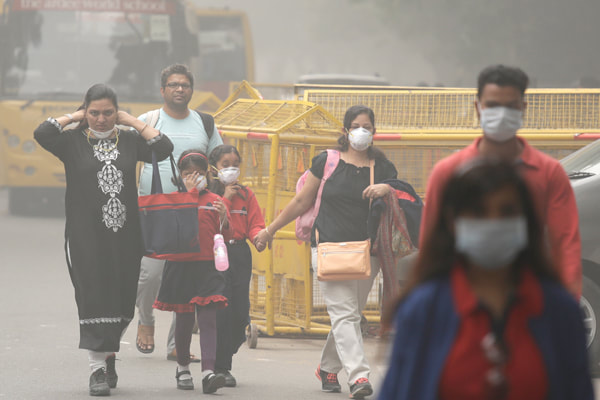|
Are you breathing clean air? Absolutely not! Only 1 in 10 people breathe safe air according to WHO guidelines. Almost 92% of the world’s population lives in places where air quality levels exceed WHO guideline; 56% of cities and towns monitoring pollution locally have levels 3 ½ times or more above WHO guidelines; 87% of death from outdoor air pollution occurs in low- and middle-income countries. Aren’t these statistics devastating? Air pollution not only brings about climatic changes but affects our health in dangerous ways which we would have not even imagined.
Air Pollution in India In India:
Delhi: Pollution levels are worst here and at an all-time high. They are 12.2 times greater than WHO safe levels (10 µg/m3). Bengaluru: Pollution levels are 6.3 times greater than WHO safe levels. Mumbai: Pollution levels are 6.3 times greater than WHO safe levels. Kolkata: Pollution levels are 6.1 times greater than WHO safe levels. Chennai: Pollution levels are 4.4 times greater than WHO safe levels. Health Impact Most sources of air pollution emit abundant quantities of CO2 that contributes to a vivacious cycle that threatens our health and climate. Minute, invisible pollution particles enter deep into our lungs, bloodstream and bodies. Such pollutants are to be blamed for almost one-third of deaths from stroke, chronic respiratory diseases and lung cancer alongside one-quarter of deaths from heart attack. Ground-level ozone which is a result of different pollutants in sunlight increases the risk of asthma and chronic respiratory illnesses. Air pollution is the leading cause of many common killers- 36% of lung cancer deaths, 35% of COPD (pulmonary disease deaths), 34% of stroke deaths and 27% of heart disease deaths. Global warming elevates the intensity of storm, drought, heat waves and enables the rapid spread of vector-borne diseases transmitted by mosquitoes, other insects and pests. Ozone affects crop growth and food productivity leading to food insecurity and undernutrition. How Can We Reduce Air Pollution As a Nation?
Manage waste: Keep emission from waste as minimal as possible. Recycle non-organic trash, compost food items, reuse grocery bags and avoid burning trash to avoid polluting the air. Plan outdoor activities: Involve yourself in outdoor activities when pollution is at its lowest, maybe early mornings or late evenings. Protect yourself: Wear a face mask that helps to filter out fine particulate matter, if advised by authentic sources. Travel mindfully: Walk, cycle or use public transportation to the extent possible. If needed, buy no or low emission vehicles to avoid black carbon that has carcinogenic characteristic which can damage our health and the climate too. WHO has set its target as 2030 to substantially reduce the number of illnesses and deaths caused due to air pollution. WHO feels that there is no short-cut action to curb air pollution. Solution exists with sustainable transport in cities, solid waste management, access to clean household fuels and cookstoves, renewable energies and reduction in industrial pollution. Comments are closed.
|
AVOID FRAUD. EAT SMART.+91 7846 800 800
AuthorDietitian & Nutritionist Dr. Nafeesa Imteyaz. Archives
November 2022
Categories
All
Dr. Nafeesa's Blog @blogspot |
- Home
- Written Testimonials
- Consult
- Clinics
- Blogs
-
Diet & Nutrition
- Diabetes Reversal
- IVF IUI not needed for PCOS PCOD Infertility
-
Medical Nutrition
>
-
Disease & Conditions
>
- Infertility | PCOS
- Diabetes Mellitus
- Cholesterol
- Hypothyroid
- Kidney Problems
- Hypertension
- Cardiovascular Diseases
- Liver Diseases
- Gastro intestinal disorder
- Cancer
- Metabolic Disorders
- Orthopedic Disorders
- Eating Disorders
- Dietary Recall
- Weight Record Filled By Clients
- Online Payment Transaction Details
- Online Clients Weight Check Form
- Our Program Package Service Charges
- Weight Record 2017 Clients
- Measurements sent by Clients
- Terms & Conditions Of Payment
- Thanks. Your Form is Submitted
- Video Testimonials
- Lifestyle & Wellness
- Lifestyle & Wellness Blog
- Allergy & Intolerance
- Weight Loss / Gain
- Weight Loss / Slimming Blog
-
Disease & Conditions
>
- Life Cycle Nutrition >
- Sports Nutrition >
- Integrity in Nutrition
- Knowledge Centre
© COPYRIGHT 2022. ALL RIGHTS RESERVED. FRST HEALTHCARE PVT LTD.
Dr. Nafeesa Imteyaz of First Eat Right clinic, is the Best Dietitian Nutritionist in Bangalore. Best Dietitian Nutritionist in Pune. Best Dietitian Nutritionist in Hyderabad. Best Dietitian Nutritionist in Chennai. Best Dietitian Nutritionist in Mumbai. Best Dietitian Nutritionist in Delhi. Best Dietitian Nutritionist in Kolkata.


